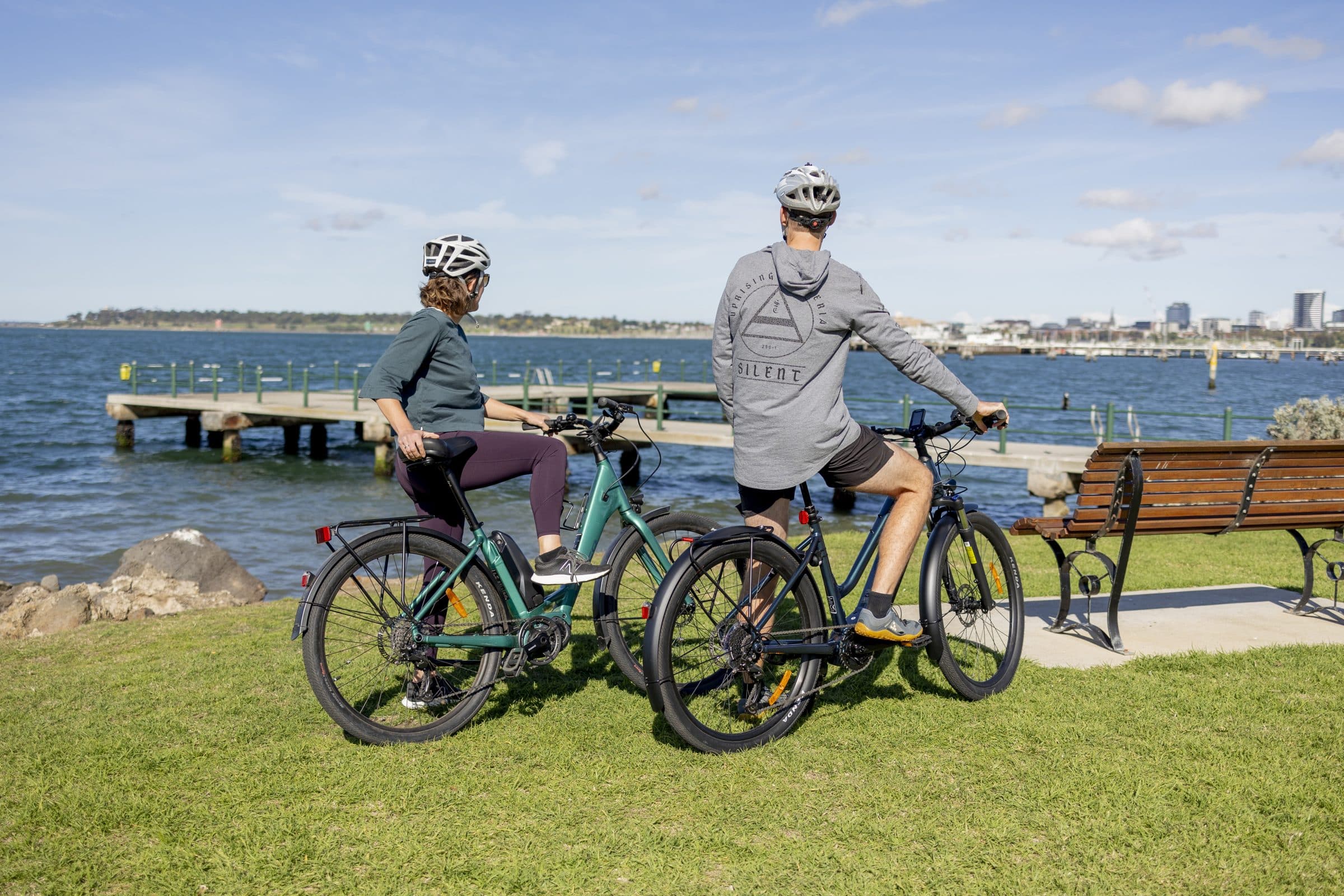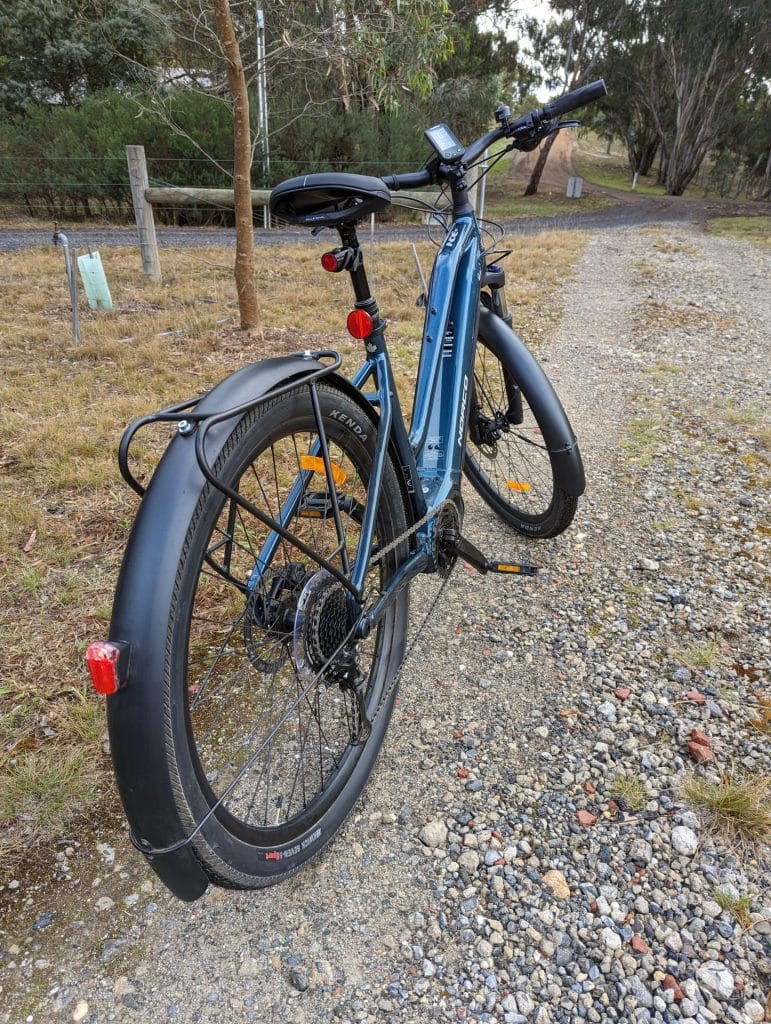
To promote sustainable transport, Geelong Sustainability is offering e-bike test rides for the community to experience what it’s like to ride an e-bike before making the purchase of your own bike!
You can come along and learn more about e-bikes at the upcoming EV and E-bike expo!
Electric bikes are ideal for all people; if you’re wanting to use your car less, easily cycle with your kids, need help getting up the big hills, your ability is declining and you need extra assistance, or you want to live a cheaper, more sustainable life, e-bikes are an enjoyable way to travel.
An e-bike, short for electric bike, is a bicycle that incorporates a battery and electric motor to assist with pedalling. E-bikes are a sustainable, zero emissions option when in operation, meaning your carbon footprint will be drastically reduced. In 2022 Australia’s transport sector made up 19 percent of total emissions, with 10 percent of that coming from cars and passenger vehicles.
We understand e-bikes cannot always replace cars for everyone but more than half the trips made by private vehicles are less than five kilometres, which you can do on an e-bike while avoiding traffic. E-bikes are especially useful for city dwellers to get around town.
Although e-bikes are higher in price than regular bikes, they will pay themselves off in approximately two years if used regularly, by saving money on fuel. Charging costs are very low (less than $50 per year), and free if you use solar energy.
Mid-range e-bikes cost approximately $2,500, with some starting as low as $1,200 and your more expensive models up to $5,000. Make sure you do your research, finding out what the bike includes and what it is you specifically want the bike for.
Some e-bikes are inherently more expensive due to their specialist designs, such as cargo bikes, mountain and trail bikes, and lightweight road bikes.

Types of e-bikes
- Recreational: also known as ‘urban’ or ‘commuter’ bikes, for everyday use.
- Road: Designed for paved surfaces.
- Mountain: Suggested to be ridden off road.
- Cargo: Designed to carry more weight, these are used for transporting goods or passengers such as kids.
- Folding e-bikes: These are compact and can be folded for easy storage and transport.
Type of assistance
- Pedelecs: Provide assistance only when you are pedalling. The motor helps to maintain a steady speed and makes pedalling easier.
- Throttle-controlled e-bikes: These can be powered by a throttle or button, similar to a scooter or motorcycle. You can ride without pedalling, using the throttle to control the speed.
Things to consider:
Servicing
Like any vehicle, e-bikes need regular servicing to maintain safety. You can expect to spend approximately $200 for a general service, which is recommended at least once a year for regular commuters. Additionally, a frequent rider might incur an extra $50 to $100 for replacement parts, such as brake pads, brake rotors and chain.
Battery
Another cost is the replacement of the e-bike battery. Like most batteries their capacity reduces over time and require replacement after approximately five years. Depending on your usage, the remaining capacity might still be adequate for your regular commute on a single charge. Replacement batteries can cost an estimated $500 – $1,200. This can seem like a large cost but small in comparison to a car.
Charging
Charging an e-bike generally takes between three to six hours, depending on the type of bike, battery size and charger. Some models offer fast charging options that can reduce this time. Mid-range bikes cost approximately 10 – 15 cents per full battery charge, which would generally give you between 50 – 100 kilometres of range.
Speed
Because e-bikes have a motor there are legal regulations that must be abided by such as a speed limit of 25 km/hour and a power limit of 250 watts. This speed can be exceeded when using pedal power only or riding down hill.
Operation mode
- Eco Mode: Provides minimal motor assistance to extend battery life, suitable for longer rides on flat terrain.
- Touring Mode: Offers moderate assistance for a balanced ride, ideal for general commuting or leisurely rides.
- Sport Mode: Delivers more powerful assistance for faster speeds and hilly terrain, enhancing performance and acceleration.
- Turbo Mode: Provides maximum motor power for the highest speed and steepest climbs, useful for challenging rides but drains the battery faster.
Motor
E-bike motors rarely need replacing they dont require servicing, the replacement chances are higher for heavily used electric mountain, or cargo bikes.
Warranty
Each manufacturer has their own warranty and claim process.
Some retailers provide a full manufacturer’s warranty, with a two year manufacturers warranty on all electrical components including batteries. The bikes frames can range from 5 years to lifetime warranties.
What to check when reviewing a warranty:
- Coverage Details: Understand what is covered and what is not. Some warranties exclude certain types of damage or wear and tear.
- Claim Process: Know how to file a warranty claim, including required documentation and whether you need to return the faulty part.
- Transferability: Check if the warranty is transferable if you decide to sell the e-bike.
- Service Locations: Find out if you need to take your e-bike to a specific service centre or if you can use local repair shops.
Insurance
Getting E-bike insurance is a great option for all riders and something that is improving with more specialists providers becoming available.
Cover can include: theft away from home, theft in home, transit cover, accidental damage, malicious damage, road hazard cover, personal accident cover and bicycle rack cover.
Insurance costs generally include basic and premium covers. For a low range ebike ($1,000) the cover fee is approximately $115 annually ($10 monthly) and a higher range ebike ($5000) a premium cover is approximately $400 annually ($33 monthly).
Safety Considerations:
E-bikes are a great safe option for transport and have safety features to compensate for the specialities of the bike including enhanced braking system, suspension and reinforced tyres. E-bike batteries should be handled carefully to avoid overheating. Some key safety considerations are:
- Charge in an open area like a garage or shed, away from exits.
- Only charge on hard surfaces that can’t catch on fire like concrete floors or tiles.
- Do not charge batteries when sleeping or not at home.
- Once the battery is full, disconnect it from the charger.
- Only charge with the supplied charger.
- Keep it cool – heat is the enemy of lithium-ion batteries, and Australian conditions are often warm. Always store your battery in a cool well ventilated place. Avoid leaving it in a hot car, storing or charging it in confined spaces, near heaters or in direct sunlight.
- Vary the throttle, running continuously at 100 percent generates a lot of heat and reduces battery life. Instead keep full throttle to short bursts, then ease off and give your battery a break.
- Have your e-bike serviced regularly and avoid modifications or activities that override the design specifications or overload the bike.
Tips for Active Transport
- Use the quiet streets in Geelong where possible
- Ride slowly – 10km/h means a sub-30 minute journey to work
- Use Google Maps for route planning
- Invest in safety gear: phone holders, LED lights, waterproof clothing
- Opt for quality tyres to avoid punctures
Local E-Bike Suppliers
In summary, e-bikes offer a practical and sustainable solution to reducing our carbon footprint and rethink our approach to everyday travel. With rising fuel costs, traffic congestion, and the urgent need to address climate change, e-bikes present a fantastic alternative that’s efficient, environmentally friendly and suitable for people from all walks of life. Whether you’re a parent, a commuter, or simply looking to lessen your car usage, an e-bike can make a significant impact.
At Geelong Sustainability, we’re excited about how e-bikes are contributing to a climate-safe future and transforming how we think about transportation. We invite you to trial our community e-bike and see how this exciting technology can be part of building the sustainable future we all need!
